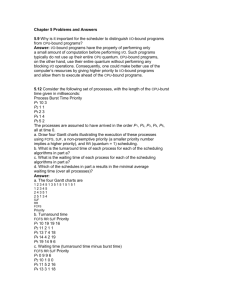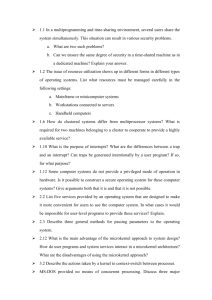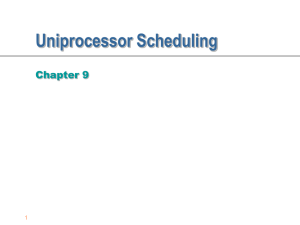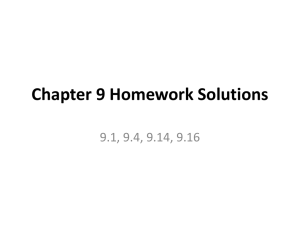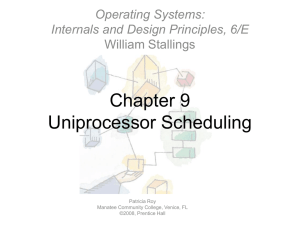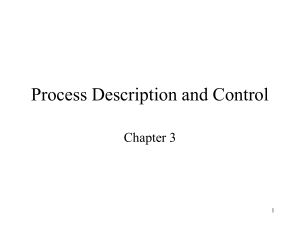Class Notes #9
advertisement
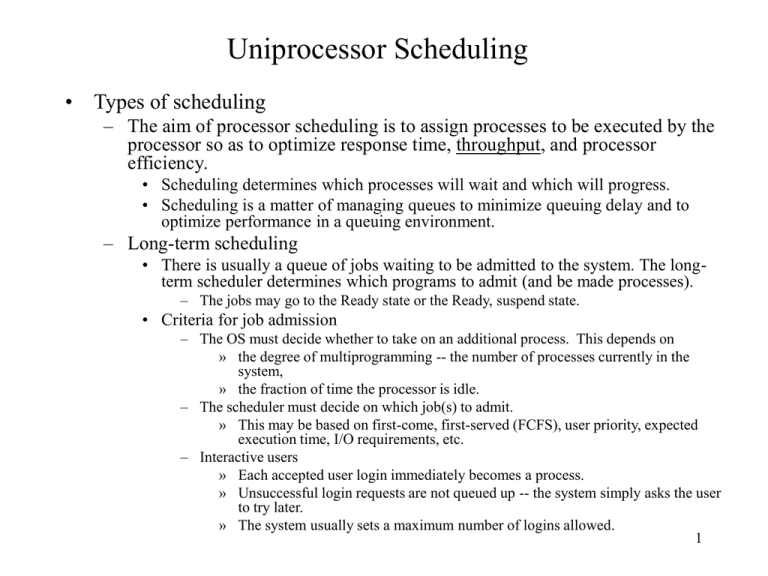
Uniprocessor Scheduling • Types of scheduling – The aim of processor scheduling is to assign processes to be executed by the processor so as to optimize response time, throughput, and processor efficiency. • Scheduling determines which processes will wait and which will progress. • Scheduling is a matter of managing queues to minimize queuing delay and to optimize performance in a queuing environment. – Long-term scheduling • There is usually a queue of jobs waiting to be admitted to the system. The longterm scheduler determines which programs to admit (and be made processes). – The jobs may go to the Ready state or the Ready, suspend state. • Criteria for job admission – The OS must decide whether to take on an additional process. This depends on » the degree of multiprogramming -- the number of processes currently in the system, » the fraction of time the processor is idle. – The scheduler must decide on which job(s) to admit. » This may be based on first-come, first-served (FCFS), user priority, expected execution time, I/O requirements, etc. – Interactive users » Each accepted user login immediately becomes a process. » Unsuccessful login requests are not queued up -- the system simply asks the user to try later. » The system usually sets a maximum number of logins allowed. 1 2 3 4 Uniprocessor Scheduling (cont.) – Long-term scheduling (cont.) – Interactive users » Each accepted user login immediately becomes a process. » Unsuccessful login requests are not queued up -- the system simply asks the user to try later. » The system usually sets a maximum number of logins allowed. – Medium-term scheduling • This is related to swapping jobs between the suspended and ready states. • Issues involved are – the number of ready processes, – whether the job is unblocked, – whether there is sufficient main memory space. – Short-term scheduling • This is related to process switching decisions due to events such as clock interrupts, I/O interrupts, OS system calls, signals, etc. • The short-term scheduler is also known as the dispatcher. 5 Scheduling algorithms • Short-term scheduling criteria – To optimize some of the following (possibly competing) criteria: • User-oriented criteria – Response time : maximize the number of users who experience an average response time below a certain threshold, say 2 sec. • System-oriented criteria – the effective and efficient use of the processor – Throughput : the rate at which processes are completed. • predictability, processor utilization, fairness, etc. • The use of priorities – Jobs are assigned priority levels. – Each priority level has its own queue of jobs. – The processor processes a lower level job only if there is no jobs waiting in all higher priority levels. – To avoid starvation, low priority jobs may acquire higher priorities through aging, i.e., their priorities increase over time. • Decision mode – Nonpreemptive policy • Once a process is in the running state, it continues to execute until it terminates or blocks for I/O or executes a system call. – Preemptive policy • The currently running process may be interrupted by the OS due to clock quantum expiration, I/O interrupt, etc. 6 7 8 9 Performance measurements of scheduling policies • • • • • arrival time service time (Ts) start time finish time turnaround time (Tr) – It is the queuing time, or total time, that the job spends in the system (waiting time + service time). • normalized turnaround time (Tr/Ts) – This number is always greater than 1. – This value indicates the relative delay experienced by a process. – Good scheduling policies try to make Tr/Ts close to 1. • Typically, the longer the process execution time, the longer the absolute amount of delay that can be tolerated. 10 11 12 13 Scheduling policies • First-come, first-served (FCFS) – nonpreemptive – Incoming processes queue in a Ready queue. – When the current running process finishes, the oldest process in the queue is selected for running. – FCFS performs much better for long processes than short ones. (See attached example.) – FCFS tends to favor CPU-bound processes over I/O-bound processes. • When a CPU-bound job is running, I/O-bound jobs must wait, even though the I/O processor is idle. • I/O-bound jobs rapidly block for I/O and release the processor. Thus CPU-bound jobs do not wait long to acquire the processor. – FCFS policy is usually combined with a priority scheme to provide an effective scheduling policy. (See below.) 14 Round-robin (RR) • • • • • • preemptive RR is also called time-slicing. Each job runs for a time quantum/slice and is interrupted by the clock. Then the job queues up at the back of the Ready queue. If the job blocks for I/O before its time slice expires, the job also queues up at the end when it becomes ready. The time quantum cannot be too small to avoid process switching overhead. – The time quantum should be slightly greater than the time required for a typical interaction. – Otherwise, most processes take at least two process switches to finish. • • RR still favors processor-bound jobs over I/O-bound jobs for the same reason as in FCFS. Virtual round-robin (VRR) – – – – This approach tries to give a fair treatment to I/O-bound jobs. There is still a Ready queue based on RR. Jobs blocked for I/O go to their respective I/O queues as usual. When done with I/O, these jobs go to an Auxiliary queue with a higher priority over the Ready queue. – When a process is dispatched from the Auxiliary queue, it runs no longer than a time equal to the basic time quantum minus the total time spent running since it was last selected from the main Ready queue. 15 16 17 Shortest process next (SPN) • nonpreemptive • This policy is FCFS based, but the process having the shortest expected processing time is selected next. • Predictability is reduced for longer processes. • Weakness: the programmer is required to estimate the required processing time. • In a production environment, where the same jobs run over and over again, statistics may be gathered. • There is a risk of starvation for long jobs, as long as short jobs keep coming. • This policy is still undesirable for an interactive environment because of the lack of preemption. 18 Shortest remaining time (SRT) • It is a preemptive version of SPN. • Whenever a new process enters the system, the process that has the shortest expected remaining processing time is chosen to run. • A new process may indeed preempt the currently running process. • Weakness: as with SPN, each job must initially give an estimate processing time. • The overhead is less than RR because there are less interrupts and process switches. • The turnaround time for short jobs is good. 19 Highest response ratio next (HRRN) • nonpreemptive • Define response ratio R = ( w + s ) / s, where w = time spent waiting for the processor s = expected service time. • w + s mimics the turnaround time of a process if this process is now selected to run. • If a new process is immediately selected to run to completion, its response ratio is 1. • The goal for a good turnaround time for a process is to make its response ratio be close to 1. • Selection criterion : when the current process completes or is blocked, choose the ready process with the greatest value of response ratio. • Shorter jobs are favored. • Long jobs will not be starved if they have waited long enough. • Weakness: expected service time is required. 20 Multilevel feedback • Criteria – – – – • • • • preemptive Favors short jobs. Favors I/O-bound jobs to get good I/O device utilization. Dynamically determines the nature/length of a job and schedule accordingly. There are n+1 queuing levels (RQ0 – RQn). Level 0 through level n-1 are FCFS. Level n is round-robin. Each level has a different quantum. – The quantum increases from level 0 to level n, e.g., 1, 2, 4, 8, 16, … time units. • New processes enter at the back of level 0. • If the job completes or blocks for I/O, the job leaves the network. • If the quantum expires before a process voluntarily relinquishes the CPU, the process is placed at the back of the next lower-level queue. – This goes on until the process reaches the lowest level. • A process at a certain level can be activated only when all higher-level queues are empty. • A running process is preempted by a process arriving in a higher queue. 21 22 Multilevel feedback (cont.) • Behavior of jobs of different nature – Interactive jobs are serviced quickly in level 0. – CPU-bound jobs • enter with highest priority; • get lower priority and wait longer as they migrate down the levels; • get more execution time in lower levels when they do get the CPU. • Refinements – The OS remembers the lowest-level of unfinished jobs leaving the queuing network (voluntarily or involuntarily). – Returning jobs usually go directly back to their previous level. – CPU-bound jobs that occasionally block for I/O do not go back to level 0. – Long jobs may suffer starvation. A remedy is to promote a process to a higher priority queue after it has waited a certain amount of time. • Adjustments for changing job nature – CPU-bound jobs may change to I/O-bound. – An unfinished process voluntarily giving up the CPU may be allowed to move up one level when it comes back. – This allows jobs to migrate back up higher levels. • The multilevel feedback queuing is an example of adaptive mechanisms. 23 • • Timing diagram for the example in Table 9.4 using the multilevel feedback policy. Assumption: time slices for levels 0, 1, 2, … are 1, 2, 4, … time units respectively. The running process is the leading one of the highest priority level. Each cell shows the processes waiting in that queue, plus the time remaining for each process. The processes are denoted by PA, PB, etc. 24
